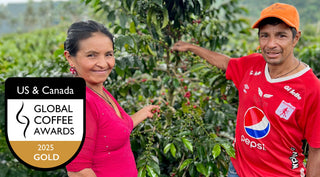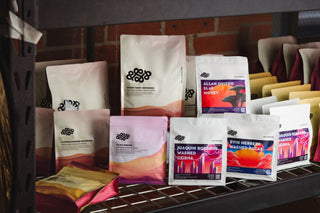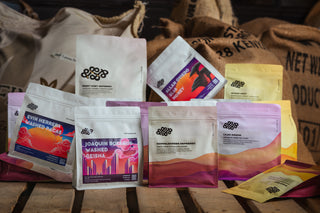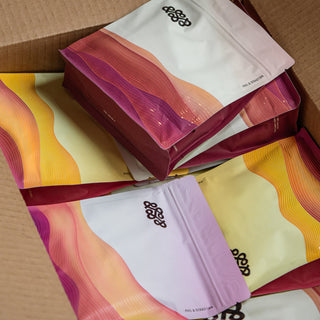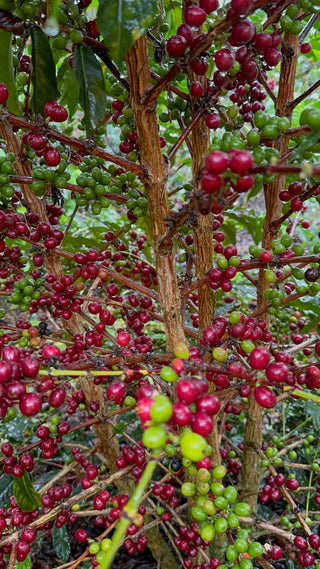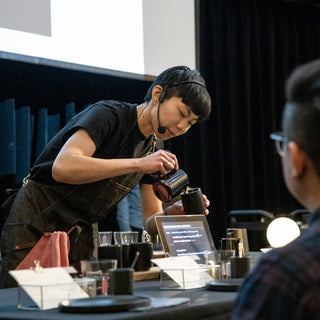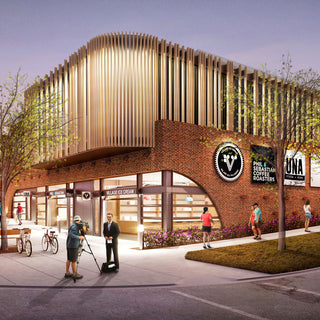We’ve been back from Costa Rica for two weeks now, and with some time to reflect, we’d love to share some of our experiences. Let’s start from the beginning, Phil and I went to Costa Rica with the intent of furthering our knowledge of Costa Rican coffees, meeting exporters and most importantly, meeting the producers and tasting their coffees.
Although Phil and I had previously visited coffee farms, we had never taken a trip with the intent of purchasing coffee at the country of origin. So this was an exciting first for us! We arrived late on Sunday night and we were picked up at the airport by the ever-animated, always on-the-run, Francisco Mena of Exclusive Coffees. Exclusive is a Costa Rican coffee exporter that works “exclusively” with small producers – more to come on Exclusive Coffees and Francisco. We had had a long trip so he took us to buy some tropical fruit and then straight to the hotel and to bed.
Day one started the right way, with a quintessential “tico” (Costa Rican) breakfast consisting of eggs, rice with beans and plantains – this dish is called “Gallo Pinto”. From there, we went to the office of exclusive coffees to meet the team, Wayner, Jose Javier, Juan Ramon and Jennifer – great, great people. Before we jumped into tasting coffees, we had a lengthy discussion with Ramon and Francisco about the state of Costa Rican coffee.
The story of how Costa Rican coffee has evolved in the past decade is a long one, but the short version is this:
Ten years ago, almost every producer took their unprocessed coffee to a large mill (or co-op), where it became more or less commoditized. While this system is convenient, it results in great coffees being “mixed-down” with others and as a result, the producer had little or no incentive to uphold quality.
Over the course of the past ten years, a number of independent producers who had well-kept farms in great micro-climates and at great altitudes, have invested in processing equipment at their farm to process (or mill) all their coffee. These independent, small, mills are now referred to as micro-mills. Needless to say, milling their own coffee is a large departure from what most producers have done all their lives. Now, the ones that have opted to mill their own coffee have to learn all the steps (there are many) involved in processing the coffee. In addition, they need to learn how to properly store the coffee, separate their lots (by coffee varietal, harvest date and/or geographical location) and ultimately, find a buyer (i.e. in Canada or other parts of the coffee consuming world) who will purchase their finished product (i.e. green coffee).
This is where Francisco, and Exclusive Coffee comes in, they’ve been working closely with many growers to encourage them to make the transition to micro-milling–by presenting the up-side–and then assisting them in their transition. Their operation was nothing short of impressive. Exclusive it walking the walk here, they’ve poured their heart into helping these growers. During our visit, we saw Exclusive host a number of courses for growers on topics ranging from milling to the economics of cost of production. But where Exclusive helps most is their follow-through to help growers get fair prices for their improved coffees, by creating relationships between buyers (such as Phil & Sebastian) and growers.
For more details on what has been happening in Costa Rica and the “micro-mill revolution”, see www.exclusivecoffeecr.com.
Anyway, back to day one. After our discussion with Ramon and Francisco, we cupped (tasted) over 40 samples of coffee from the three regions we were going to be visiting, the Central Valley, the West Valley and Terrazu. Tasting coffee at origin is an entirely different experience. Whenever we taste coffee at origin, we are reminded of how astonishingly fresh the coffee tastes and how well articulated the flavours are – it fortifies our resolve to find ways to get coffee from origin back to Calgary as quickly as possible so that everyone can have an opportunity to taste the wonders of fresh-harvested coffee.
In the afternoon, we had the privilege of traveling to the Central Valley with Juan Ramon Alvarado – who is a partner in Exclusive Coffees, but also, along with his wife Natalia, owns several farms and operates the mill Brumas del Zurquis. Ramon is a very warm and friendly chap and was a great guide. Later that day we had the pleasure of cupping some of his coffee and the cup reflects the love and passion behind the man.
That night Francisco was invited to speak at a meeting in a bank, which was launching a new initiative aimed at lending money to coffee growers who want to evolve their coffee operation (i.e. start their own mill, create more environmentally friendly initiatives). Although Phil had a difficult time focusing, as he understood only 16 of the spanish words in 2 hours (all the coffee words), I had the distinct pleasure of speaking, and presenting the perspective of Phil & Sebastian, a micro-roaster who supports the micro-mill movement, to the bankers and producers present at the meeting (Spanish came in very handy during this trip). It was very interesting to see the faces in the audience as I explained that customers really do care about the people behind the coffee and that we (i.e. Phil) spend countless hours trying to figure out how to roast their coffees in order to best represent them.
Day 2 started with a 50 coffee cupping session (4 flights) of coffees mostly from the West Valley and some from Terrazu. That’s where we fell in love with some coffees for the first time. Right after lunch, we got in Francisco’s truck and left San Jose for the West Valley, where we would spend the next two days.

